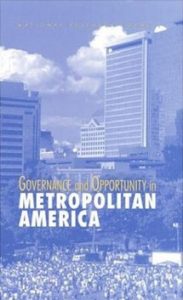Governance and Opportunity in Metropolitan America
 The Committee on Improving the Future of U.S. Cities Through Improved Metropolitan Area Governance was charged with examining metropolitan problems and their relationship to metropolitan governance. Determining that the future of U.S. cities merited serious attention by the Academy, the Three Presidents’ Committee of the National Research Council (NRC), composed of the presidents of the National Academy of Sciences, the National Academy of Engineering, and the Institute of Medicine, provided funds to support the study. The committee gratefully acknowledges additional support received from the Rockefeller Foundation for its information-gathering activities.
The Committee on Improving the Future of U.S. Cities Through Improved Metropolitan Area Governance was charged with examining metropolitan problems and their relationship to metropolitan governance. Determining that the future of U.S. cities merited serious attention by the Academy, the Three Presidents’ Committee of the National Research Council (NRC), composed of the presidents of the National Academy of Sciences, the National Academy of Engineering, and the Institute of Medicine, provided funds to support the study. The committee gratefully acknowledges additional support received from the Rockefeller Foundation for its information-gathering activities.
The committee’s original scope of work and plan of action envisioned a focus on a small number of “problems of metropolitan areas” (transportation, environmental regulation, and residential segregation were suggested); the unifying concern was to be “the extent to which current governance structures contribute to improvements in these areas or exacerbate the problems.” The committee’s task was thus a logical extension of two previous NRC reports: Urban Change and Poverty (1988) was concerned with demographic and economic trends affecting urban areas and their central cities, and Inner-City Poverty in the United States (1990) focused more intensively on the extent and location of neighborhood poverty and the question of neighborhood effects.
Following the original charge, the committee began by making clear that its conception of urban was metropolitan in scope, and therefore we took urban problems to mean metropolitan-area problems. Metropolitan problems were defined as problems affecting the entire metropolitan area or significant parts of it or problems caused by the characteristics of metropolitan areas.
William Morrill, Harold Wolman, and Faith Mitchell, editors
National Academy Press, 1999